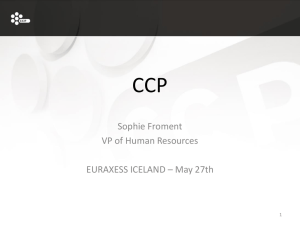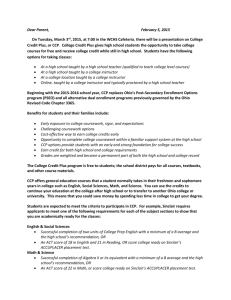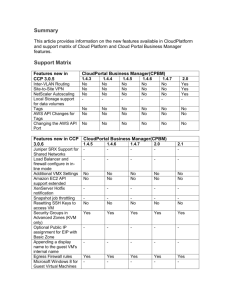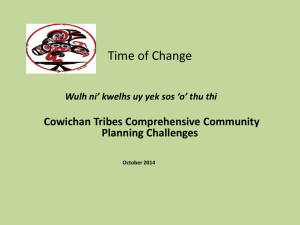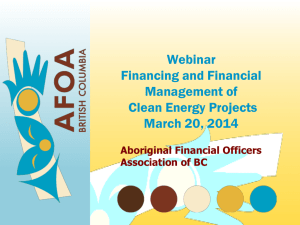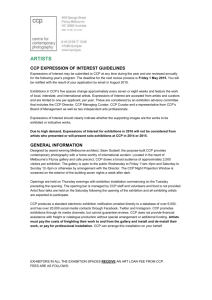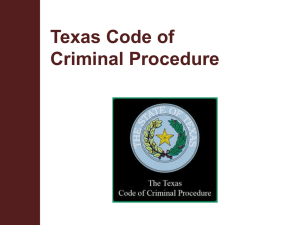ALP Form 1 CCP Form 3 & Form 4 - Curriculum Management and
advertisement
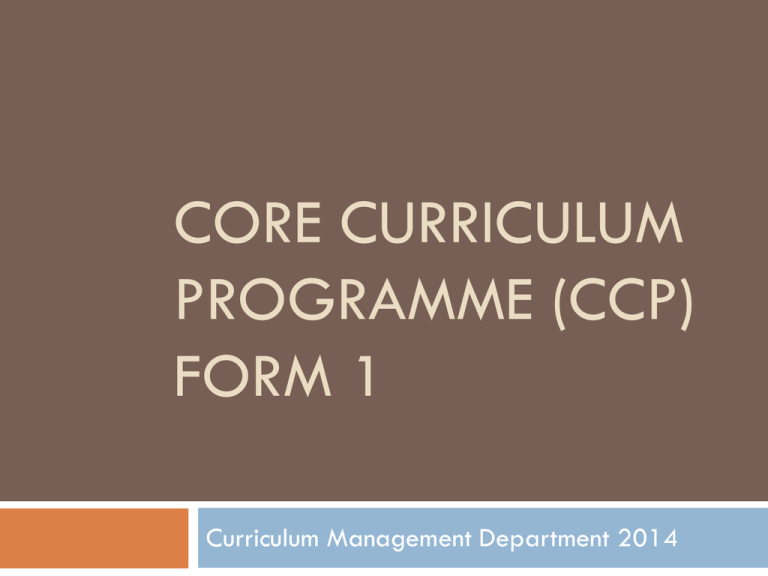
CORE CURRICULUM PROGRAMME (CCP) FORM 1 Curriculum Management Department 2014 Important characteristics Learner centred learning Assessment for Learning pedagogy Parental involvement High quality teachers School leadership support ICT enabled learning environment Meetings for teachers & mentors Assessment (ongoing & summative) Emphasis Effort to encourage these students to move up to level 5-7 class Aims Ensures learners are given opportunities to acquire the core components of the curriculum that include the key competences through a methodology that is more task based and hands on. Provide learning programmes that have a strong element of continuous assessment that will value the outcomes achieved during the course. Emphasis on the effort that must be done to encourage these students to move up to level 5-7 class CCP Form 1 Time Table Subjects Number of Lessons Maltese 5 (+1) English 6 (+1) Maths 5 (+1) Religion/Ethics 2 Science 4 ICT 1 PHE 3 PE + 2 HE/D&T (~13 weeks each) Expressive Art 2 PSCD 2 History + Social Studies + Geography Mentoring (Soft Key Competences) 2, 1, 1 1 Difference between 40 lesson time table and CCP Form 1 Curriculum 1 lesson more in Maltese, English, Maths if possible. 1 lessons mentoring: Soft Key Competences Flexibility Introduce CCP as developed by DCM Introduce CCP but with modifications to what is developed by DCM CCP not introduced at all Develop a modified programme that provides for the entitlement of the learners and respects the ability of the learner. The AIM will always be to reinsert these learners in the mainstream after this intervention. CCP Form 1 Mentor http://www.ncfhe.org.mt/uploads/filebrowser/Descriptors_of_Key_Competen ces.pdf CCP Mentor Form teacher for the CCP class 1 lesson Will address the ‘soft’ competences in the EU Key Competences Framework: o Learning to learn o Entrepreneurship o Social and Civic Competence o Cultural Awareness and Expression Pedagogy Inquiry Based Learning with Assessment for Learning used as the underlying pedagogy. Learners engaged in hands on activities working towards known outcomes. Assessment Mostly Continuous Assessment based on the achievement of these outcomes. (60%) Summative Assessment during half yearly and annual examination. (40%) Assessment grade based on the combination of the continuous and the summative. Conversion of mark to grade Mark Grade Criteria 80 - 100 MO 51 - 79 P Partially achieved expected learning outcomes 31 - 50 S Starting to work towards expected learning outcomes 1 - 30 WB Mastered expected learning outcomes Working below expected learning outcomes Maltese and English Languages CCP set class for Maltese and English within the low bands Speaking, Listening, Reading, Writing More time on Speaking 10-15 minutes reading per lesson Mathematics and Science CCP set class within the Mathematics setting of the lowest band. CCP set class within the Integrated Science setting of 3 groups formed from 2 classes within the lowest band. A number of tasks and experiments will be tackled and continuous assessment will be based on the accomplishment and evidence provided by working through these tasks. Students following Level 4 – 6 (CCP) A separate CCP class will be set for English, Maltese, Mathematics and Science The students following the CCP programme will be in different classes with other students of the same band, for the rest of the subjects Choosing Professionals Creative Teachers with a high sense of initiative. Mentors who are able to create networks with other teachers teaching the group, with guidance teachers, with the INCO, with the Learning Support Zone teacher. LSAs who collaborate with teachers and allow the learners to provide true evidence of learning. No more than 2 LSAs in one class Continuous Professional Training Both mentors and teachers teaching this group will be trained by their EOs during the next scholastic year. Parents Parents should be well informed prior to inserting the student in the programme. Parents need to sign a consent form. Parents need to be kept updated about the progress of their son/daughter. Check-list: School-based alternative programme (SBP) The total number of students on SBP needs to be contained. Learners selected according to the same criteria as per the CCP. The curricular entitlement of these students is to be respected. SBP needs to be engaging, hands-on and applied. Maximum class size – 13 students. Main aim of programme needs to remain that of reinstating these learners into the mainstream.
